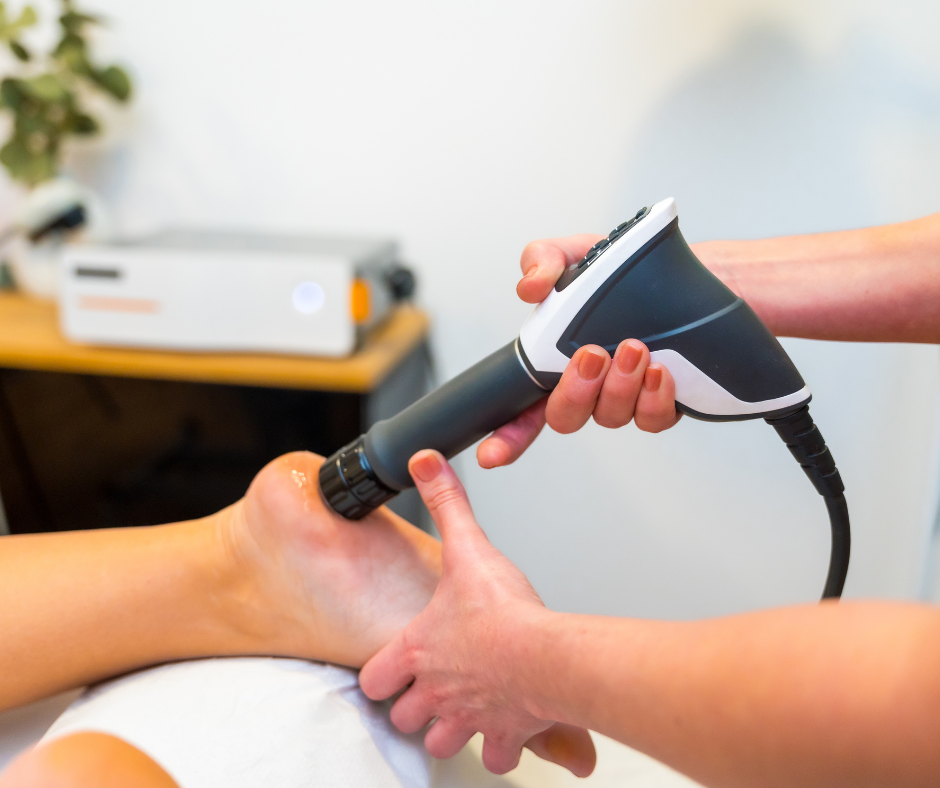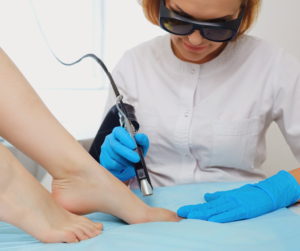-
Bunion Basics: Understanding That Bump on Your Foot
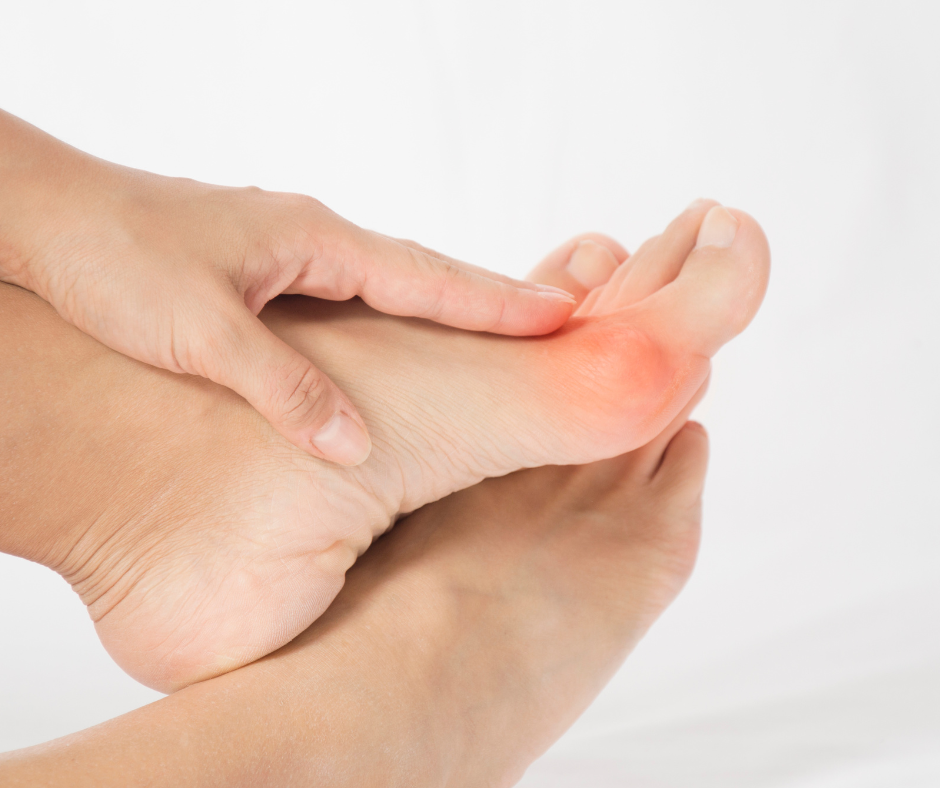
It’s a typical day…until you put on your shoes. That’s when you notice a bony bump forming at the base of your big toe. What is it? How did it get there? And why does it seem to be “drifting” towards your second toe?
If this sounds familiar, you might be dealing with a bunion, medically known as Hallux Valgus. To keep you informed on why bunions form and what to watch for, Kentlands Foot & Ankle Center is breaking down the basics below.
What’s a Bunion?
A bunion isn’t just an overgrowth of bone. It represents a change in the actual bony framework of the front part of your foot.
- The long bone connected to the big toe (the first metatarsal) starts to drift outward, and the big toe itself begins to point inward towards the smaller toes.
- This misalignment creates the characteristic bump on the side of the foot at the base of the big toe.
Bunions are often progressive, meaning they tend to get worse over time if not managed appropriately.
Why Do Bunions Form?
While ill-fitting footwear gets a lot of blame, the primary cause of bunions is usually:
- Heredity: The biggest factor! Certain inherited foot types and faulty foot mechanics (like excessive pronation or flat feet) make you more susceptible to developing bunions. If your parents or grandparents had bunions, you might be more likely to develop them, too.
- Foot Structure & Biomechanics: The way your foot functions when you walk can place abnormal stress on the big toe joint, contributing to the deformity over time.
- Footwear (The Aggravator): While usually not the root cause, shoes that are tight, narrow, or have high heels can definitely aggravate an existing bunion and potentially accelerate its progression. They force the toes into an unnatural position.
Less common causes can include foot injuries or certain types of arthritis.
Spotting the Signs: Bunion Symptom Checklist
How do you know if that bump is truly a bunion? Look for these common signs:
- The Bump: A bony prominence on the side of your foot at the base of the big toe.
- Toe Drift: Your big toe angling towards your second toe.
- Pain or Soreness: Discomfort around the big toe joint, often worse when wearing shoes or after activity.
- Redness & Swelling: Inflammation around the bony bump.
- Corns or Calluses: These can develop on the bump itself, between the big and second toes, or even on the ball of the foot due to altered pressure.
- Restricted Motion: Decreased flexibility or stiffness in your big toe joint.
- Difficulty Fitting Shoes: Finding shoes that are comfortable and don’t irritate the affected area.
Diagnosis Matters!
Even if your bunion isn’t causing significant pain yet, early evaluation allows us to confirm the diagnosis, rule out other conditions, and plan the best course of treatment for your unique needs. Affected? Don’t suffer in silence. Schedule your appointment and move toward relief today!
Interested in learning more? We’re always happy to help! Schedule a comprehensive foot examination with Kentlands Foot & Ankle Center podiatrist Dr. Jon M. Sherman. To make your appointment, please call our office at 301-825-9697.
-
Spring Forward with KeryFlex Nail Restoration!
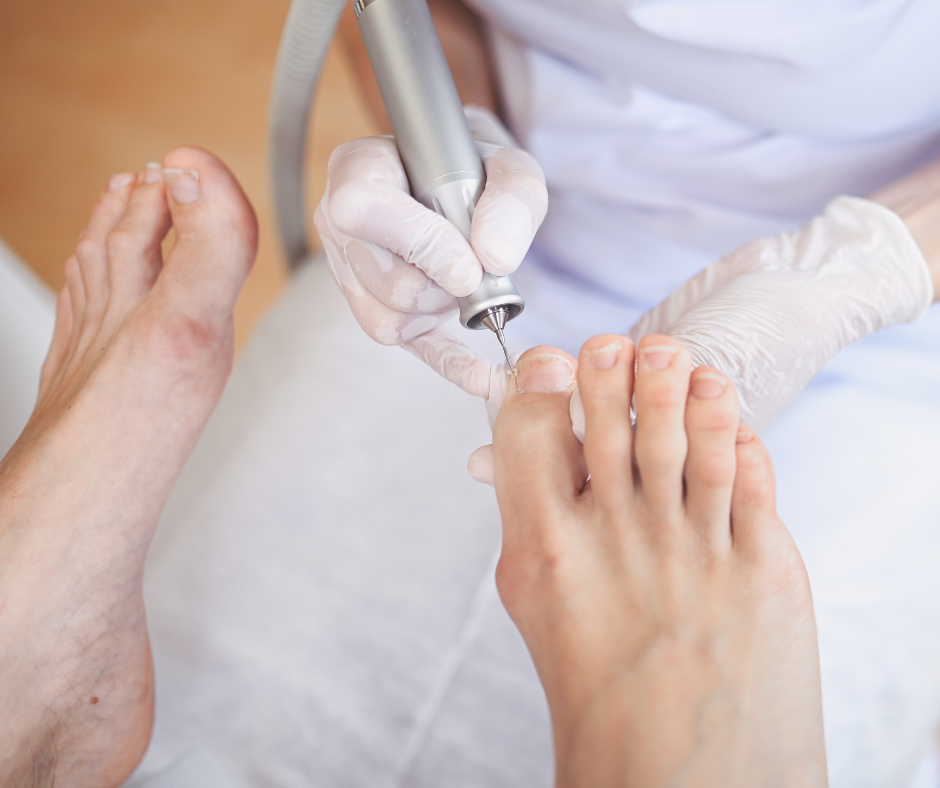
Hiding your toes due to damaged, discolored, or unsightly fungal nails? Don’t let that keep you from enjoying everything that spring has to offer! At Kentlands Foot & Ankle Center, we’re offering a powerful treatment that’s gaining traction with patients in your shoes: KeryFlex Nail Restoration.
What is KeryFlex?
KeryFlex isn’t an artificial nail, nor is it a simple cosmetic cover-up. It’s a specially formulated, flexible, non-porous resin that bonds to the existing nail (or what’s left of it), creating a realistic, natural-looking nail plate.
Importantly, KeryFlex doesn’t bond to the skin or irritate it. It adheres to the callous cells of the nail or the papillary roots, making it safe and comfortable.
More Than Just a Quick Fix
“Dystrophic” is a medical term for nails that are damaged or abnormal in appearance. KeryFlex is an excellent option for patients with a variety of nail disorders, including:
- Onychomycosis (Fungal Nail Infections): Thickened, discolored, crumbly nails.
- Nail Trauma: Nails damaged by injury.
- Psoriasis: Nail changes associated with psoriasis (pitting, discoloration, thickening).
- Ingrown Toenails: While KeryFlex doesn’t treat ingrown toenails, it can improve the nail’s appearance after the ingrown portion is addressed by a podiatrist.
- Onychogryphosis (“Ram’s Horn Nails”): Severely thickened, curved nails.
- Beau’s Lines: Horizontal ridges or grooves in the nail.
- Koilonychia (“Spoon Nails”): Abnormally thin, concave nails.
Why Choose KeryFlex?
Results are often rapid, and you’ll likely walk out of our office with a natural-looking nail – no waiting for months for the damaged nail to grow out!
The application is painless, so it requires no anesthesia. Additionally:
- KeryFlex moves with your foot and toes, providing a comfortable, natural feel. It’s flexible yet durable enough to withstand everyday activities.
- Unlike acrylic nails, KeryFlex doesn’t trap moisture, making it a suitable option even if you’re undergoing treatment for a fungal infection.
- In fact, it can be used concurrently with topical antifungals or in conjunction with PinPointe Laser Therapy.
The KeryFlex Application Process: Quick and Easy
KeryFlex is applied by trained and certified providers in our office, and you can resume normal activities immediately. The process is simple: we prepare your nail, apply the KeryFlex resin, sculpt it to a natural shape, and cure it with a UV light!
Ready to help you step out in style in your open-toed shoes of choice? Schedule a comprehensive foot examination with Kentlands Foot and Ankle Center podiatrist Dr. Jon M. Sherman. To make your appointment, please call our office at 301-825-9697.
-
Clear Fungal Nails with PinPointe FootLaser
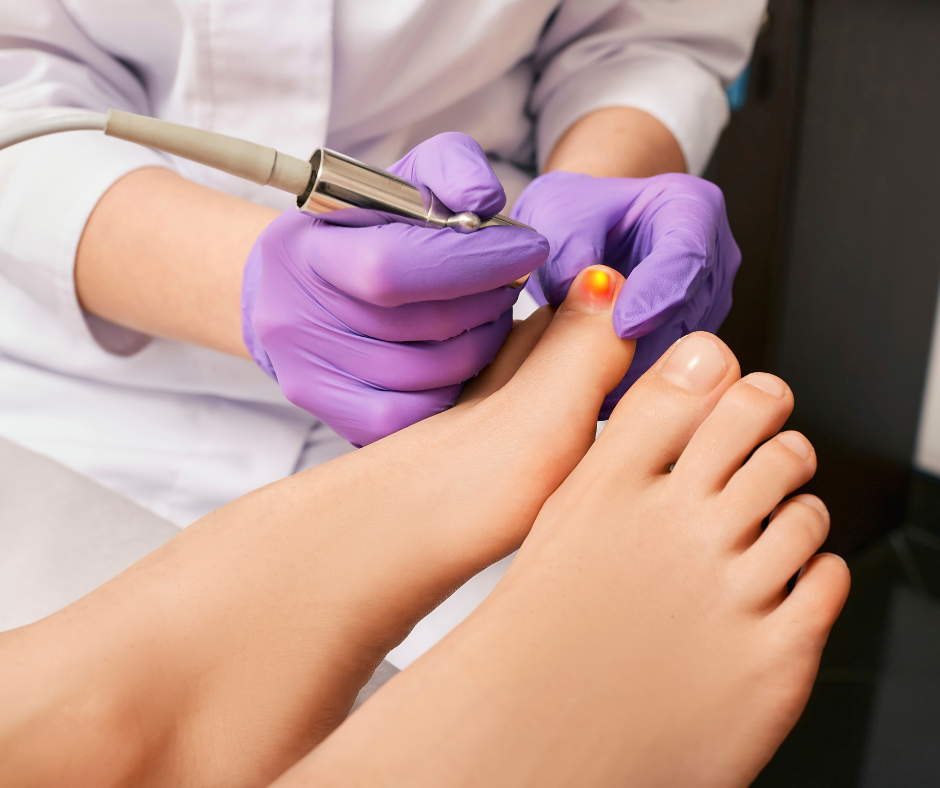
Are you hiding your feet because of embarrassing fungal nails? You’re not alone. Millions suffer from onychomycosis, a common fungal infection that can cause thickening, discoloration, and even pain. If you’ve tried over-the-counter treatments with little success, it’s time to consider a more powerful solution: the PinPointe FootLaser. At Kentlands Foot & Ankle Center, we’re proud to offer this advanced technology to help you achieve clear, healthy nails.
Why Choose PinPointe FootLaser?
The PinPointe FootLaser is an FDA-cleared device specifically designed for the treatment of toenail fungus. It offers several advantages over traditional methods:
- Clinically Proven Effectiveness: The PinPointe FootLaser has demonstrated significant success rates in clinical studies. It is a fast and effective treatment option that has been used for many years.
- Targets the Fungus Directly: Unlike topical treatments that struggle to penetrate the nail plate, the PinPointe FootLaser delivers laser energy directly to the source of the infection, beneath the nail.
- Safe and Painless: The procedure is generally painless, requiring no anesthesia and causing no damage to the surrounding tissue. Patients typically feel a warm sensation during the treatment. The laser is safe to use and has no known side effects.
- No Downtime: You can return to your normal activities immediately after the procedure.
- Avoids Systemic Side Effects: Unlike oral antifungal medications, the PinPointe FootLaser has no risk of liver toxicity or other systemic side effects.
How the PinPointe FootLaser Works
The PinPointe FootLaser emits a specially designed laser beam that passes through the toenail and targets the underlying fungal organisms. The laser energy heats and destroys the fungus without harming the surrounding healthy tissue. The procedure is quick, typically taking about 30 minutes to treat both feet. Most patients only require one treatment to achieve their desired result.
What to Expect During Treatment
When you come to Kentlands Foot & Ankle Center for PinPointe FootLaser treatment, you can expect a comfortable and professional experience.
- Consultation: Dr. Jon M. Sherman will thoroughly examine your nails, discuss your medical history, and determine if you’re a good candidate for laser treatment.
- Preparation: Your nails will be cleaned and prepared for the procedure.
- Treatment: The laser will be applied to each affected nail, delivering pulses of energy to target the fungus. You will likely feel a warming sensation as the laser works.
- Post-Treatment Care: We’ll provide you with detailed instructions on how to care for your nails after the procedure to maximize results. You can resume normal activities immediately after treatment.
If you’re ready to step out of the shadows and reveal clear, healthy nails, the PinPointe FootLaser may be the solution you’ve been searching for. Get in touch and step toward better health today.
Interested in learning more? We’re always happy to help! Schedule a comprehensive foot examination with Kentlands Foot & Ankle Center podiatrist Dr. Jon M. Sherman. To make your appointment, please call our office at 301-825-9697.
-
Custom Orthotics, Biomechanics, and You: Step into Better Health with 3D Scanning
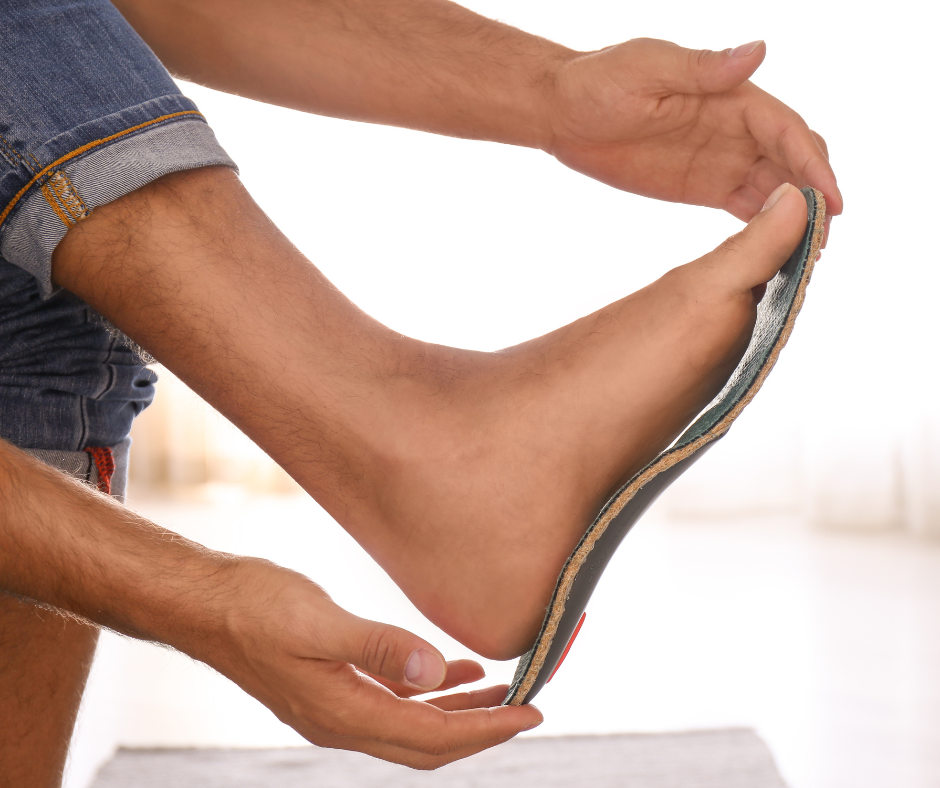
Our feet are the foundation of our bodies, and proper biomechanics – the way our muscles, bones, and joints work together – are essential for pain-free movement and overall well-being.
Custom orthotics can play a vital role in optimizing your biomechanics, and advancements in 3D scanning technology are revolutionizing the way these supportive devices are created. In this post, Kentlands Foot & Ankle Center explains how new tech is providing orthotics that are better than ever for all kinds of issues, so read on to learn more!
Understanding Biomechanics
When your feet don’t function optimally, it can throw off your entire body’s alignment. This can lead to a variety of issues, including:
- Foot Pain: Plantar fasciitis, heel spurs, bunions, and metatarsalgia.
- Knee Pain: Misalignment leading to patellofemoral pain syndrome or IT band syndrome.
- Hip and Back Pain: Caused by altered gait and posture.
- Balance Problems: Increased risk of falls, especially in older adults.
- Sports Injuries: Stress fractures, shin splints, and Achilles tendonitis.
Custom Orthotics: Tailored Support for Your Unique Needs
Unlike over-the-counter inserts, custom orthotics are specifically designed to address your individual foot structure and biomechanical imbalances. They provide targeted support and cushioning, helping to:
- Improve Weight Distribution: Evenly distribute pressure across your feet, reducing stress on specific areas.
- Enhance Balance and Stability: Provide a stable base of support, improving balance and reducing the risk of falls.
- Correct Gait Abnormalities: Guide your feet into a more natural and efficient gait pattern.
- Prevent and Aid Recovery from Sports Injuries: Offer shock absorption and support to reduce strain on joints and soft tissues.
The 3D Advantage: Precision and Personalization
Traditional methods of creating orthotics, like plaster casting, can be messy and imprecise. 3D scanners, on the other hand, can capture a highly accurate digital model of your feet in seconds, providing a detailed blueprint for crafting truly customized orthotics.
- Superior Accuracy: 3D scans capture the intricate contours of your feet with unparalleled precision.
- Dynamic Assessment: Some advanced scanners can even analyze your gait while you walk or run, providing a dynamic assessment of your foot function.
- Faster Turnaround: Digital models can be instantly sent to the lab, speeding up the fabrication process.
The result? A pair of custom orthotics that fit your feet like a glove, providing optimal support and comfort in one.
Interested in learning more? We’re always happy to help! Schedule a comprehensive foot examination with Kentlands Foot & Ankle Center podiatrist Dr. Jon M. Sherman. To make your appointment, please call our office at 301-825-9697.
-
ESWT Shockwave Therapy Offers a New Approach
Chronic heel pain can make everyday activities like walking and standing unbearable, and while traditional treatments like stretching, orthotics, or injections might provide some relief, they can sometimes fall short.
Enter ESWT (Extracorporeal Shock Wave Therapy), a non-invasive alternative that’s changing the game for heel pain sufferers! Kentlands Foot & Ankle Center is always at the forefront of innovative, non-invasive options, and for this blog post, we’re going to cover all the ins and outs of this exciting option, including why it might be the right choice for you.
The Limitations of Traditional Approaches
Traditional treatments for heel pain, such as physical therapy and the use of orthotics, can be helpful in the initial stages.
- However, they often provide only temporary relief and may not address the underlying cause of the pain.
- In some cases, these treatments can be time-consuming, require a long recovery period, or have unwanted side effects.
ESWT: A Non-Invasive Solution
ESWT is a treatment that utilizes pressure waves to stimulate healing and reduce pain and inflammation. Unlike traditional surgery, ESWT doesn’t involve incisions, anesthesia, or a lengthy recovery period. It also boasts high success rates that are clinically verified.
How ESWT Works
ESWT targets the affected tissue with high-energy pressure waves, stimulating a healing response and promoting tissue regeneration.
- This can be particularly effective for conditions like plantar fasciitis, where the plantar fascia, the thick band of tissue along the bottom of the foot, becomes inflamed.
Shockwave Therapy vs. Traditional Surgery
- No Cutting: ESWT avoids the need for incisions, reducing the risk of complications associated with surgery.
- Faster Healing: Recovery from ESWT is significantly faster. For example, traditional heel spur surgery might require between six weeks and three months for a full recovery.
- Reduced Risk: ESWT eliminates the risk of permanent nerve or joint damage associated with some surgical procedures.
- Minimal Downtime: Patients can typically return to work and daily activities much sooner after ESWT compared to surgery.
- Less Pain: ESWT generally involves less post-treatment pain than traditional surgery.
Aching and unsure options? Consult with your podiatrist to see if ESWT is right for you!
Interested in learning more? We’re always happy to help! Schedule a comprehensive foot examination with Kentlands Foot and Ankle Center podiatrist Dr. Jon M. Sherman. To make your appointment, please call our office at 301-825-9697.
-
National Diabetes Awareness Month: Do’s and Don’ts

November is National Diabetes Month, so the time is right to emphasize how diabetes impacts both your overall health and your feet in particular.
Kentlands Foot & Ankle Center knows how overwhelming it can be to manage this chronic condition alone, so with that in mind, we’ve gathered some helpful hints and tips to make at-home management far easier. Keep reading to learn the “Do’s and Don’ts” of diabetic foot care, courtesy of our expert team!
DO: Practice Good Nutrition
What you eat directly affects your diabetes management and foot health: high blood sugar can damage nerves and blood vessels, leading to serious complications.
- Do: Load up on fiber-rich foods like whole grains, fruits, vegetables, and legumes. These help regulate blood sugar, promote good digestion, and keep you feeling full for longer.
- Do: Choose lean protein sources like fish, poultry, beans, and lentils for essential nutrients without excess saturated fat.
- Do: Include healthy fats from avocados, nuts, seeds, and olive oil to support heart health.
DON’T: Forget Daily Foot Checks
Early detection is key to preventing serious foot problems.
- Don’t: Skip your daily foot inspection! Look for cuts, blisters, redness, swelling, or any changes in skin color or temperature.
- Don’t: Hesitate to contact your podiatrist if you notice anything unusual! Early intervention makes a big difference.
DO: Schedule Regular Podiatrist Visits
Routine care and regular foot screenings allow for early recognition of problems like ulcers, which can reduce the risk of lower limb amputation by up to 85%.
- Do: See your podiatrist at least once a year for a comprehensive foot exam, even if you don’t have any noticeable problems.
DON’T: Wear Restrictive Footwear
Certain shoe styles can worsen foot problems or restrict circulation.
- Don’t: Wear high heels, tight shoes, or pointed-toe shoes that squeeze your toes.
- Don’t: Wear shoes without proper arch support, especially if you have flat feet.
Wondering what else you can do to manage the complications of diabetes? We’ve got one more “Do” for you, then: give us a call and get in touch today!
Schedule a comprehensive foot examination with Kentlands Foot and Ankle Center podiatrist Dr. Jon M. Sherman. To schedule your appointment, please contact our office at 301-825-9697.
-
Laser Therapy: A Natural Approach to Pain Relief
Chronic pain harms your quality of life, and while traditional treatments like surgery or medications may offer temporary relief, they often come with side effects and recovery times. Fortunately, that’s not the case with laser therapy, a non-invasive and drug-free approach that’s emerged as a promising alternative for individuals seeking effective pain management. In the following blog, Kentlands Foot & Ankle Center will tell you all about it.
How Does It Work?
Laser therapy, also known as cold laser therapy or low-level laser therapy, utilizes light energy to stimulate healing and reduce pain.
- Laser light penetrates the skin, targeting damaged cells and promoting tissue regeneration.
- This process involves increasing the production of ATP, a cellular energy molecule, which facilitates repair and cell growth, analgesia, and reduced inflammation.
- By harnessing your body’s natural healing abilities, laser therapy provides long-lasting relief.
The Benefits
Laser therapy offers several advantages over traditional treatments: It’s:
- Non-invasive: No medications, cortisone injections, or surgery required.
- Drug-free: Avoids potential side effects associated with medications.
- Simple: Typically involves 5-7 treatment sessions, allowing for a quick recovery.
- Effective: Studies have shown an 85% permanent reduction in inflammation and pain in many cases.
Applications
Laser therapy can be used to treat a wide range of acute and chronic conditions.
- Tendinopathies, such as Achilles tendonitis, respond particularly well, but it also works to address complications that arise from bursitis (inflammation of fluid-filled sacs that cushion joints), shin splints (pain along the shinbone caused by overuse), and plantar fasciitis (heel pain caused by inflammation of the plantar fascia).
Experience the Benefits
If you’re suffering from chronic pain, this may be a suitable option for you. At Kentlands Foot & Ankle Center, we emphasize patient education, so please feel free to reach out if you’d like to learn more about laser therapy and how it can help you regain your quality of life.
Want to beat chronic pain for good? We’re eager to help! Schedule a comprehensive foot examination with Kentlands Foot and Ankle Center podiatrist Dr. Jon M. Sherman. To schedule your appointment, please contact our office at 301-825-9697.
-
5 Common Foot and Ankle Injury Myths in Sports

From little league to professional sports, foot and ankle injuries are some of the most common among athletes. And unfortunately, many misconceptions and myths surround these issues, which can hinder recovery.
In this post, we will debunk these myths to help athletes better address their foot and ankle troubles.
Myth 1: All Ankle Sprains Are the Same.
Fact: Ankle sprains vary in severity, ranging from mild to severe. While most ankle sprains involve the ligaments on the outside of the ankle, some can also affect the ligaments on the inside. That’s why you should seek a medical evaluation to determine the extent of the injury.
Myth 2: You’re Right, Coach. I’ll Rub Some Dirt on It.
Fact: Continuing to play with pain can worsen an injury and delay recovery. If you experience pain in your foot or ankle, it’s important to rest and seek medical attention. Overuse injuries and stress fractures are common for athletes who are too stubborn to stop.
Myth 3: Rest Or Surgery. There’s No In Between.
Fact: While rest is often recommended for minor injuries and surgery is sometimes required for season-ending injuries, there lies a full spectrum of intervention between these two extremes:
- Physical therapy: Exercises to strengthen the surrounding muscles and improve stability.
- Corticosteroid injections: These injections can help reduce inflammation and pain in the affected joint.
- Anti-inflammatory medications: Over-the-counter or prescription medications can help alleviate pain and reduce inflammation.
- Orthotics: Custom orthotics may be necessary to address underlying foot mechanics.
Myth 4: All Foot Pain is Caused by Plantar Fasciitis.
Fact: While plantar fasciitis is a common cause of foot pain in athletes, it’s not the only possibility. Other conditions, such as Achilles tendonitis, turf toe, neuromas, and others listed above, can cause pain and limit performance.
Myth 5: Once an Injury Heals, You’re Good to Go.
Fact: Even after an injury heals, it’s important to continue rehabilitation exercises to prevent re-injury. Strengthening the surrounding muscles and improving flexibility can help enhance stability and reduce the risk of recurrence.
Want to start taking your foot and ankle health seriously? We’re happy to help! Schedule a comprehensive foot examination with Kentlands Foot and Ankle Center podiatrist Dr. Jon M. Sherman. To book your appointment, please call our office at 301-825-9697.
-
Don’t Lose Your Mojo: Signs, Symptoms, and Treatments for Broken Toe
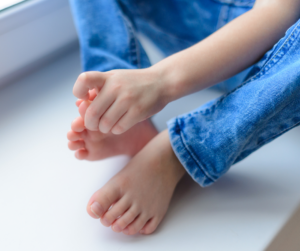
If you’ve ever dropped something on your foot or jammed it on something hard, you might have been close to breaking your toe. Broken toes are one of the most common breaks in the human body, and they can be seriously painful injuries that require prompt and careful rehabilitation.
That’s why at Kentlands Foot and Ankle Center, we are here to un-stub the toe fracture confusion, providing expert insight and advice along your path to better foot health.
Signs and Symptoms of a Broken Toe
Because a broken toe often causes immediate and severe pain, it’s helpful to distinguish it from other potential foot injuries like turf toe and toe sprains:
- Intense pain: Sharp and localized pain at the point of impact.
- Swelling: Rapid onset of swelling around the injured toe.
- Bruising: Discoloration may appear within a few hours.
- Deformity: The toe may appear visibly crooked or misshapen.
- Difficulty walking: Putting weight on the injured foot may be painful.
Prognosis for a Broken Toe
Most toe fractures typically heal within 4-6 weeks. However, the specific recovery time can vary depending on the severity of the fracture and the person’s overall foot health.
While most broken toes heal without complications, there is a small risk of developing arthritis in the affected toe in the future. Additionally, if the fracture is not properly aligned, it may result in long-term pain or deformity.
Treatment and Recovery
Most minor toe fractures can be treated at home with the RICE method (rest, ice, compression, elevation) and over-the-counter pain relievers prescribed by your podiatrist. In some cases, your podiatrist may recommend taping or splinting the toe to immobilize it and promote healing.
Crutches or boots are typically not necessary for a broken toe unless there are multiple fractures or associated injuries. However, it’s essential during recovery to avoid putting excessive weight on the injured foot. Physical therapy may also be recommended to gently regain strength and flexibility after the bone has healed.
Want to stay on top of your foot and ankle health this summer? We’re happy to help! Schedule a comprehensive foot examination with Kentlands Foot and Ankle Center podiatrist Dr. Jon M. Sherman. To schedule your appointment, please call our office at 301-825-9697.
-
Protect Your Feet from the Summer Sun

Just like the rest of your body, your feet are susceptible to sun damage. UV rays penetrate the layers of your skin, causing sunburn, premature aging, and increasing the risk of cancer. While the soles of your feet have thicker skin, the tops and ankles are vulnerable, especially for people who wear sandals or flip-flops regularly.
If we diligently protect our faces and arms with sunscreen, why should we neglect our feet? Here’s why you shouldn’t forget about protecting them from the sun’s harmful UV rays, according to our expert team at Kentlands Foot and Ankle Center.
The Risks of Sun-Exposed Feet
- Actinic Keratosis: These precancerous lesions appear as rough, scaly patches on skin exposed to the sun, especially during summer. While not cancerous themselves, they can develop into skin cancer if left untreated.
- Squamous Cell Carcinoma: This is a type of skin cancer that can develop on the sensitive areas of the feet. Early detection can decrease the risk of complications, so be aware of any changes in the appearance of your skin, such as new moles, persistent scaling, or bleeding.
- Age spots: These are flat, brown spots that commonly appear on sun-exposed areas, including the tops of the feet. While benign, they can be a cosmetic concern for some.
- Pre-existing skin conditions: Sun exposure can worsen existing skin conditions on the feet, such as eczema or psoriasis, leading to increased itching, inflammation, and discomfort.
Protecting Your Feet This Summer
- Sunscreen: Apply broad-spectrum sunscreen with SPF 30 or higher to the tops of your feet and ankles 15 minutes before sun exposure. Reapply every two hours, especially after swimming or sweating.
- Sun-Protective Footwear: Wear closed-toe shoes or sandals with straps that cover the tops of your feet. Look for materials like canvas or mesh that allow for ventilation while providing some sun protection.
- Examine Your Feet Regularly: Pay attention to any changes in the appearance of your skin, such as new moles, discolored spots, or changes in texture. If you notice anything concerning, consult a podiatrist.
Want to keep your feet happy and healthy this summer? We’re eager to help! Schedule a comprehensive foot examination with Kentlands Foot and Ankle Center podiatrist Dr. Jon M. Sherman. To schedule your appointment, please contact our office at 301-825-9697.
RECENT POSTS
categories
- Uncategorized
- Featured Articles
- Foot Disorders
- Broken Ankle
- Broken Toe
- Fracture
- Foot Health
- Foot Care
- Arthritis
- Foot Pain
- Skin Cancer
- Podiatry Appointment
- Custom Orthotics
- Podiatrist
- Diabetes
- Gout
- Heart Health
- National Nutrition Month
- National Foot Health Awareness Month
- Foot Safety
- Foot and Ankle Injuries
- Falls Prevention
- Chronic Heel Pain
- Shoes
- Laser Therapy
- Quoted
- Physical Therapy
- KeryFlex
- Sweat
- Summer Foot Care
- Sports Injury
- ESWT
- Fungal Toenails
- Bunion



